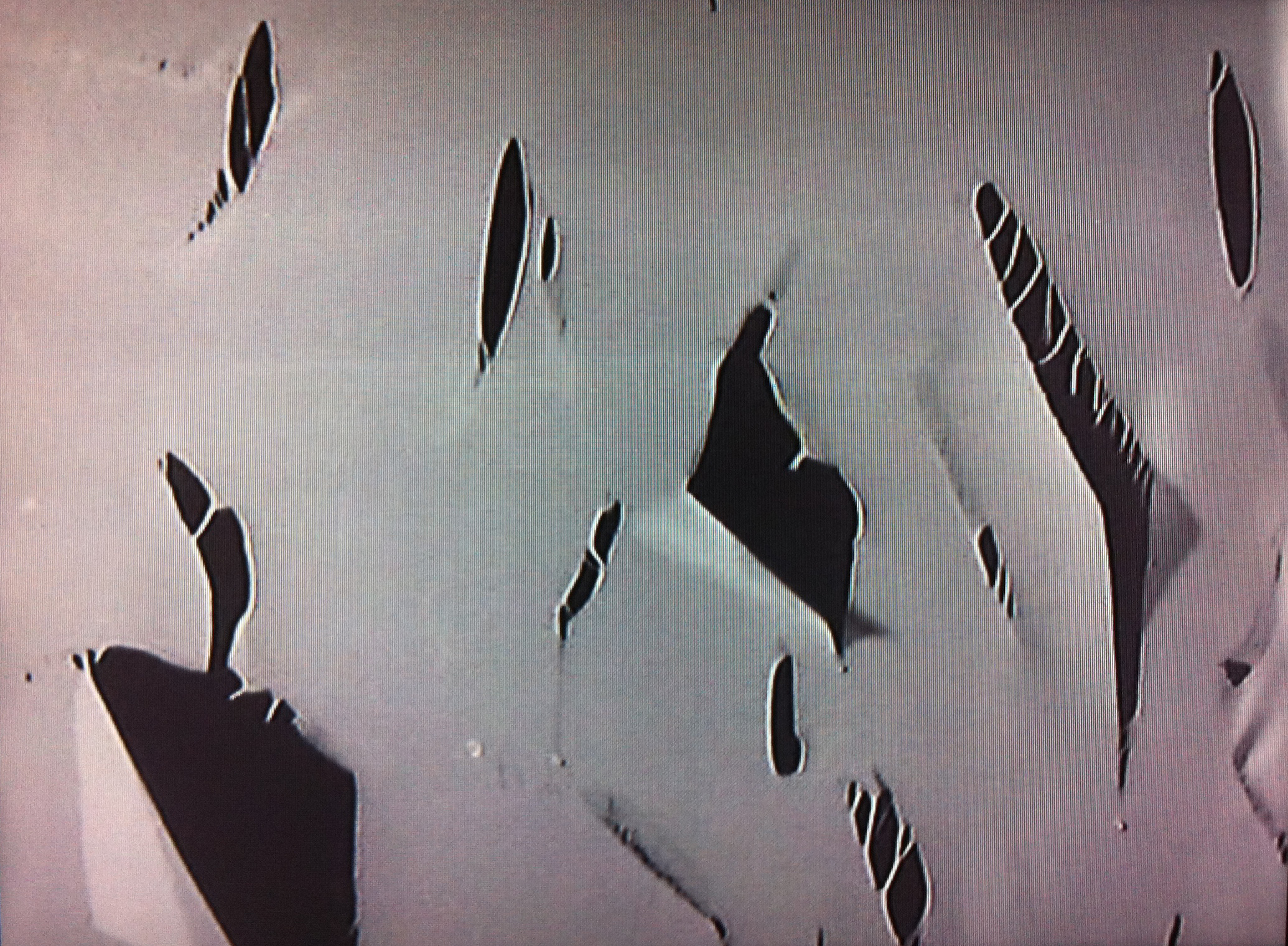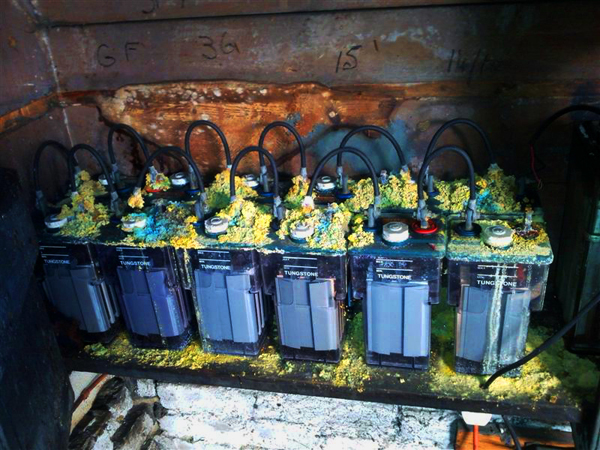— Construction with Steel and Technology

Gustav M. watched as his giant sculpture, a thirty-foot non-reflective steel cube packed with computers, smartphones, and tablets, all a few years old now, was lifted high above the ground, swinging at the end of a crane’s chain. Already, even though Gustav had only packed the cube with equipment less than half a decade ago, and the steel had been of high quality, there was seepage as chemicals leeched out of their obsolescent electronic packets, tiny odd bumps were beginning to appear on the dull surface, and the whole thing was beginning to give off an air of internal turmoil.
Gustav M. had finally managed to convince the gallery that this piece, Construction with Steel and Technology, should be placed outside the gallery, not shoved meekly in one corner next to works by Tinguely, Moholy-Nagy, and Ettore Colla, much as he approved of their work. Besides, he was concerned that when the rotten and corroded machinery finally fully burst through, it would have a deleterious effect on his chances of ever exhibiting again, if it took a couple of other sculptures down with it. No, the piece belonged outside, on the roundabout, where cars and bikes and buses would judder past it, jangling the equipment inside and speeding the demise of the work until one day it would lie in pure rubble, indistinguishable from the world around it.
Gustav M. wished he didn’t have to give a talk that evening. He’d been invited to speak by some group calling themselves “The Aesthetic Accelerationists,” though he found their image of capitalism and technology rather shallow. The Aesthetic Accelerationists had been hovering around him for months now, emailing half-formed questions, demanding short articles from him for their various new online magazines, and now this, a public lecture in a gallery. Gustav M. did not want to give a lecture. He really did not like artists.
He had prepared some notes, however, meaning to address something that had been bothering him for a long time: namely the responsibility artists have to the rest of the world. He glanced over them as he sat on the wall outside the gallery. “To go on limiting oneself to achievement strictly within the rules of a profession laid down by a society that is on the point of collapse, is, to me, a betrayal!” Gustav M. was tired of the solipsism of the art world, its interminable parasitism and its dominance, the way money washed through everything and how much nonsense was perpetuated in its name. Yet, at the same time, the art world was in a sense the world, or at least a part of it, and could hardly be blamed for being as awful as what surrounded it.
But he found it astonishing how little artists did beyond their own world, how little responsibility they felt they had for nature, for politics, for wars perpetuated in their name, for other human beings. Not all artists were like this, of course, and he felt a lot of admiration for some of the groups he’d heard speaking at political events and at protests. Groups like Precarious Workers’ Brigade and Arts Against Cuts who thought politically about everything they did, whether it was where to exhibit, whose money to take, or whether it was better to concentrate on something beyond art at a particular moment. But still, these groups were tiny and barely funded. Gustav M. felt that art should be financed by external bodies, not be part of this capitalist racket if it could help it. He glanced down at his notes again. “Auto-destructive art will be financed by the state, local authorities, the universities and—monopoly capitalism. I know this involves enormous contradictions, but the theory is full of contradictions.” The only trouble was, Gustav M. reflected, nobody seemed to pay attention to the real contradictions, and only made art that was about petty things of no consequence.
Auto-destructive art was the steel cube, it was art that attempted to bring destruction into the center of consciousness, a kind of psychoanalysis of the audience through objects. The Aesthetic Accelerationists didn’t seem to get it, Gustav M. reflected—they just liked the fact that there was a massive cube filled with computers, because they thought that computers were cool and would usher in communism, or something. Although, Gustav M. sighed, their image of communism was unlike any he’d heard of before, consisting of flying robots and automated machines for everything. It was clear to him that nature would likely perish even faster if these goons ever got any power. But they wouldn’t, would they?
Half an hour before the talk, a small dog ran up to Gustav M., its lead untethered to an owner’s hand. He petted it gently, and let it lick him. It seemed lost and childish, unmoored from its bourgeois function. A middle-aged man rushed up: “Dada! There you are! Leave this poor man alone!” Gustav sighed. What a city this was, where dogs were named Dada.
There were about seventy people in the audience. Most of them looked young, a bit bored, but simultaneously eager with pens and notebooks in hand. Young art students, he guessed, keen to fill their head with the wisdom of someone who’d seen a few decades, and might pass on a few anecdotes about other artists. After a lengthy but phony introduction, Gustav M. began:
Auto-destructive art seeks to remind people of the horrors which they are perpetuating, and is a warning and an admonition to reverse this direction.Well, that woke them up a bit. A couple of students shuffled in their seats. Gustav M. began to expound his theory of auto-destructive art, wondering if any of the crowd had noticed the giant steel cube on the roundabout outside:
Auto-destructive art is dangerous. We cannot know all the effects it is likely to have on some people. But social developments have not been halted because of considerations such as these: the people who will launch the attacks against auto-destructive art on these grounds should ask themselves if they cannot find powerful windmills to combat.A few people laughed at the windmills remark. But not enough, Gustav M. thought. Fine, I’ll move on to the details, he thought.
Matter leaves a work in fragments. These fragments could be in the form of solid blocks which hit the ground without shattering and are eventually removed. It is a misconception that all parts of an auto-destructive art sculpture have to disintegrate. Other fragments shatter on impact. Fragments leave the work as a result of explosions. Vibration may shatter fragments. Forms implode. Matter is carbonized and pulverized. Most of these transformations are visible. Many disintegrative processes are not visible. They take place very slowly or on a microscopic level.

Just as he was about to continue describing the process of disintegration, an incredibly large BANG filled the room. My God! Gustav thought, we’ve been targeted by a drone strike! Bewildered, the audience started to stand up and glance questioningly at each other. What on Earth had happened? Someone shouted “it’s outside!” and people rushed to the gallery steps. The steel cube was visible, its insides pouring out onto the road, spewing machines onto the asphalt. Gustav M. was confused: the process should not have happened so quickly! Then he spotted something vile: a burning body in the center of the cube. What on Earth?
Someone said: “That’s Johnny!” People were starting to scream, terrified and overwhelmed by the sight of the body, which had now fallen over on top of a pile of outdated Apple laptops that themselves slid out to join their smashed brethren on the road. The traffic had stopped confusedly, some drivers were getting out of their cars. Suddenly a recorded voice boomed out from some unseen place: “This was an action by the Nihilists for Auto-Destruction! Comrade Johnny sacrificed himself in the name of speeding up the destruction of this most important work by Gustav M.! We believe in the hurrying up of horror! Join the Nihilists for Auto-Destruction today!”
Gustav M. sighed. This was not what he had meant at all.
×


